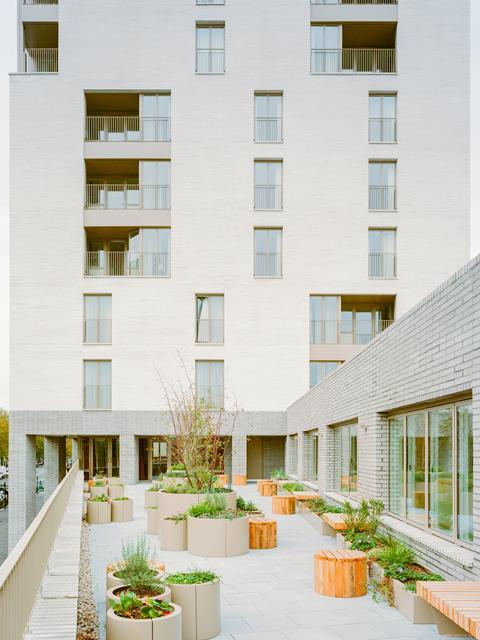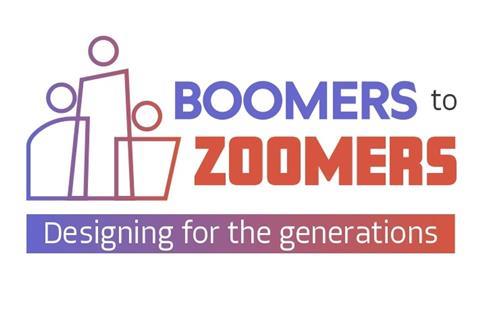As BD launches its new campaign, Ben Flatman sets out the challenges and themes that it will explore

There has been a growing realisation over the past decade that much of our built environment fails to meet the needs of important, but often overlooked sections of society. Arguably foremost among these are children and young people. The covid pandemic exposed in the starkest way the disparities that the youngest in society often face in terms of access to safe spaces beyond the home.
Jonny Anstead, founding director of TOWN, a leading developer, and chair of the Quality of Life Foundation, has spoken about the way in which his company seeks to include the needs of young people, but is damning about the UK’s overall performance.
“New housing development across the country [is] overwhelmingly mediocre or poor,” he told a parliamentary inquiry into young people and the built environment this year. “The path of least resistance is to create an environment that is very good for refuse and highways, but which is very poor for children.
“The cities and countries that are most effective at getting neighbourhoods to work better for children really see children as a prism or lens through which to see the whole of the planning system,” he added.
“It’s a strategic question… about how a focus on children makes concrete what good places look like – they’re walkable, they’re compact, they’re green. It also helps to build a long-term vision and consensus about what good places… feel like.”
But it is not just children who are being let down. An entire generation of young adults is dealing with the UK’s failure to think about and plan for their futures, with all the associated impacts this has on their ability to lead full lives, access work and start families.
Belatedly, the private sector is implementing innovative – and sometimes controversial – solutions to the housing crisis, such as co-living, but it is clear that even more radical thinking will be needed.
>> Also read: Boomers to Zoomers campaign
>> Also read: We are neglecting the needs of young people, planning experts tell MPs
Changes to the way that people work are also fuelling the need for new intergenerational solutions, although our towns and cities have been slow to respond. The Gen Z, “Zoomer” generation – those fully accustomed to working remotely and online – have different expectations of what constitutes a great workplace.
How should architects and urban designers respond to meet these needs, while still accommodating an older generation for which a face to face culture and presenteeism are still prized?

While the UK’s inverted pyramid of property wealth has gifted many of the baby boomer generation an unprecedented level of affluence, there are still plenty of older people who are struggling. Many find themselves asset rich but cash poor, or were never homeowners in the first place.
And, as this campaign will highlight, plenty of commentators argue that increased property prices, and a lack of quality accommodation, have in many ways trapped whole generations on rungs of the housing ladder that no longer suit them.
Some point to the UK’s focus on home ownership as being itself a fundamental barrier to people living fulfilling lives, and to economic prosperity. The Economist called it “the West’s biggest economic policy mistake” and “an obsession that undermines growth, fairness and public faith in capitalism”.
Many architects argue that alternative types of tenure and housing delivery models could help a variety of different age groups access the homes they need.
Dysfunction abounds in the way that built environment policy and practice has failed to keep up with changes in the ways that people live and work. But the fortunate flipside to this narrative is that the UK’s architects and designers are brimming with possible solutions, and simply awaiting the opportunity to put them into action.
Here are some of the key themes and challenges that the Zoomers to Boomers: Designing for the Generations campaign will be exploring, including insights from some of the campaign’s expert editorial advisers.
Children and young people
Margaret Thatcher is often associated with the UK’s fondness for home ownership, but she was also a keen advocate of the “great car-owning democracy”. She saw cars as an important symbol of a free society. Indeed, for the postwar generation, a car was often a very real manifestation of individual liberty, opening up a whole new world of personal and family autonomy.
However, as with increased home ownership, the UK’s prioritisation of the car brought with it a range of unintended – and perhaps still not fully appreciated – consequences. While cars may have liberated adults, for children their impact was more malign, shrinking the world around them, increasing dependence on adults for mobility, and leading to increasing confinement in the home.
Over time, the spaces that children had considered theirs – the streets outside their homes – became gigantic linear car parks. Cars not only made streets increasingly unsafe for people of all ages, but especially for hard-to-spot children. Largely unfounded parental concerns around “stranger danger” conflated with very real fears their children would be hit and killed on the road.
The freedom to play and cycle in the street and to explore local neighbourhoods became the exception rather than the norm. In 2018 the Children’s Commissioner described today’s children as “the least active generation ever”, while numerous reports show a precipitous decline in the amount of time that children spend playing outside and walking to school, since the 1970s.

Cars are “probably the primary issue”, says Dinah Bornat, director of ZCD architects, when asked to explain how this happened. “It has played a massive role in parents not wanting their children to walk to school and not being comfortable with them just being out, playing.”
Bornat is a leading advocate for the importance of play within the public realm, and a firm believer that, when young people’s needs are to the fore in architecture and urban design, then the wider community also benefits.
She has also been one of the key instigators of the current levelling up, housing and community committee’s parliamentary inquiry into young people and the built environment at Westminster, and despairs of what she sees as a lack of joined-up thinking on the issue in government.
Clive Betts, the Labour MP chairing the inquiry, opened proceedings by stating how hard it had been to find a government minister able to respond to questions on the subject area. While “there is a plethora of guidance”, says Bornat, no one in government is connecting the dots across departments on housing, health and education, to see how the built environment potentially links all of them.
Intergenerational living and new models for housing
There are a wide range of models that the UK could be exploring to address housing needs for all age groups. One idea that the campaign will be exploring is intergenerational living, which has the potential to help address affordable housing shortages and loneliness by creating dynamic, supportive communities.
This approach involves creating homes where multiple generations can coexist, sometimes blending families under one roof. These designs typically feature flexible spaces, including private areas for each generation alongside shared common areas.
Multigenerational living can help to reduce individual financial burdens as costs for rent, utilities and maintenance are shared, making living arrangements more accessible to low-income families, young adults, and older people.

Alex Ely, director at Mae Architects, believes the generations have much to offer each other. “We’ve got a portion of our population who are retiring early, but are still very able and capable,” he says.
“They’re often interested in using their social capital to build skills – or share them with the next generation.
“So, for example mentoring new businesses and promoting intergenerational support networks. I think that’s the beauty of designing around age-friendly principles – that you can potentially draw on the social capital of people who have time on their hands to actually support those who don’t.”
Intergenerational living also has the potential to help combat loneliness, particularly among the elderly and young adults. Those in later life benefit from daily interactions, reducing isolation and improving mental health.
For young families, having elders present can be invaluable for childcare, sharing the responsibilities of raising children. And older adults can offer guidance and emotional support, enriching the upbringing of children with diverse perspectives and experiences.
Workplace
Workplaces are evolving to meet the diverse needs of an intergenerational workforce, accommodating varying expectations and work styles. Today’s workplaces must address the preferences of Baby Boomers, Gen X, Millennials, and Gen Z (the “Zoomers”), each bringing unique perspectives.
Baby Boomers and some Gen Xers typically favour a traditional, face-to-face approach, valuing in-person interactions and a structured environment. Millennials and Gen Z, however, prefer flexibility and a work-life balance.
These younger generations are comfortable with digital tools and remote work, seeking environments that support work-from-home options and flexible schedules. They also value workplace culture, diversity and opportunities for professional development.

Despite the differences in approach, work has an almost unparalleled potential to bring people together. For Darryl Chen, partner at Hawkins Brown, whose practice has researched the intergenerational workplace, it is the commonalities that are key to building inclusive intergenerational space.
“Our main conclusion from the research, in a nutshell, was that there were a lot of things that young people were feeling that old people were feeling as well,” he explains. “In the UK, for example, a lot of loneliness and disconnectedness.”
He sees this as a key reason why modern workplaces are integrating flexible work arrangements, such as hybrid models that combine remote and on-site work. This approach accommodates those who thrive on face-to-face interaction and those who excel in remote settings.
Additionally, there is a growing emphasis on mental health support, wellness programmes, and state-of-the-art facilities like collaborative workspaces, quiet zones, and recreational areas.
Later-life living

The design of later-life living accommodations is evolving to address the needs of older adults while benefiting broader society. A key need is the provision of downsizing options for those in later life who still live in large family homes.
This transition not only meets their changing needs but also frees up valuable housing stock for younger families, potentially alleviating housing shortages.
Modern later-life living communities emphasise strong connections to the wider community. This integration allows people to remain active and engaged, participating in social, cultural, and civic activities.
Rather than isolating the elderly, these communities are designed to be vibrant parts of towns and cities, ensuring that older adults maintain meaningful roles in society.
Design-conscious approaches are transforming senior housing, with a focus on creating appealing spaces, moving beyond the outdated model of basic, uninspired facilities. Thoughtful design incorporates elements like accessible outdoor spaces, and communal areas that foster social interaction.
Crucially, the best new later-life living accomodation, such as Mae’s Daventry House scheme in Westminster, is being integrated into the fabric of towns and cities rather than being relegated to the fringes. This avoids the ghetto-isation of the elderly, ensuring that later-life living is part of mixed-use developments that enhance the urban public realm.
Education and skills
Architectural education and skills training are crucial in addressing contemporary social issues in the built environment. The Architects Registration Board (ARB) is reforming architectural education, offering a timely opportunity to reframe the architectural discourse to tackle significant societal challenges.
These reforms aim to equip future architects and urban designers with the skills and knowledge necessary to design inclusive communities.

Innovative housing models, such as intergenerational living, could play an important role in addressing housing shortages and enhancing community cohesion.
Ensuring that architects are equipped to address these challenges will partly depend on the profession reflecting the communities it seeks to serve. “Our population, and the people we are designing for, come from a range of diverse backgrounds, so it is important that those who shape our built environment reflect this,” says Peter Sofoluke, director at BPTW Architects.
The “Zoomers to Boomers: Designing for the Next Generation” campaign launched by BD is poised to address these critical issues, highlighting the need for architectural solutions that cater to all age groups. Engagement willl be crucial in addressing these issues, especially by involving young people.
To get in touch with us about the campaign, please contact Ben at ben.flatman@bdonline.co.uk
Evidence suggests that including them in decision-making processes around the built environment can strengthen communities, leading to better local facilities, higher employment, increased cultural access and improved well-being. However, their voices are often overlooked.
Ensuring that young people have a say not only empowers them but ultimately leads to better outcomes for everyone.
By examining how our built environment impacts children, young adults and seniors, the campaign seeks to inspire innovative design approaches that foster inclusive, supportive and vibrant communities.
To get in touch with us about the campaign, please contact Ben at ben.flatman@bdonline.co.uk

Boomers to Zoomers: Designing for the Generations
BD’s campaign is being guided by an editorial panel, drawing on expert advisers from across architecture, planning and urban design.
The editorial panel includes:
- Dinah Bornat, founding co-director of ZCD Architects
- Alex Ely, founding director of Mae Architects
- Darryl Chen, partner at Hawkins Brown
- Satish Jassal, founding director of Satish Jassal Architects
- Kathy MacEwen, independent planning consultant and former head of planning and enabling at CABE
- Anna Mansfield, director at Publica
- Setareh Neshati, head of development at Westminster City Council
- Sarah Robinson, associate director at The King’s Foundation
- Peter Sofoluke, director at BPTW architects
















No comments yet